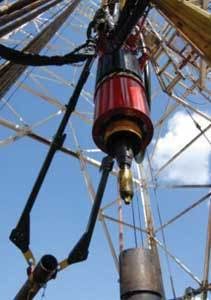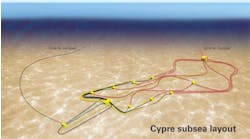Frank Hartley, Houston
Developing downhole valve technology
Saudi Aramco and Schlumberger have agreed to jointly develop a range of new technologies for intelligent completions that will lead to electrically activated downhole control valves and would facilitate a theoretically unlimited number of intelligent laterals per well.
This joint development project is part of Saudi Aramco’s overall vision to develop extreme reservoir contact (ERC) wells. ERC wells are intelligent multilateral wells that do not require individual control lines from the wellhead to each lateral or zone, which allows an unlimited number of intelligent laterals.
Earlier, Saudi Aramco pioneered intelligent maximum reservoir contact (MRC) wells, which attain more than 5 km (3 mi) of contact with the reservoir through intelligent side laterals of the main wellbore that can be partially or fully opened and closed from the surface. Haradh Increment III, the most recently developed field, was completed in early 2006 with a production capacity of 300,000 b/d of oil, relying on 32 intelligent MRC wells.
Unlike the ERC wells, MRC wells have a limited number of laterals (four to five) because each downhole control valve requires a mechanical control line to the wellhead. The ERC wells would relax this requirement by replacing the mechanical lines with electric activation. Aramco envisions 50 to 100 ERC wells to drain the reservoir and maximize recovery.
The development project will be executed by a technical team comprising researchers from Saudi Aramco’s EXPEC ARC and Schlumberger research and technology centers, including the Schlumberger Dhahran Research Center.
Permanent installation of intelligent completion systems depends on the reliability of the downhole actuation system. The new technology will employ inductive coupling at the connections between the laterals and the main wellbore to ensure long-term operational integrity.
Top-drive tubular handling system
Weatherford recently has had a series of successes with its OverDrive casing running and drilling system, a top-drive tubular handling system that the company began commercializing in May of 2006.
Shell, Brent Delta, Offshore UK used this system to run 18,209 ft (5,500 m) of 9 5/8-in. premium threaded casing in the long tangent section of a problematic extended reach dwelling well. The combination of this system and a reamer shoe allowed Shell to skip the hole conditioning run, overcome several obstructions in the well and safely got the casing string to TD.
Developed to enhance the safety and efficiency of top-drive casing running and drilling operations, the system rotates, reciprocates (or pushes down), and circulates the casing string while running to help prevent differential sticking. The system achieves high-speed string rotation when drilling with casing and includes a unique means of monitoring torque output, while removing people from hazardous rig floor and derrick operations, Weatherford says.
Additionally, Shell Atwood Falcon, Malaysia used this system with the TorkDrive 750 HD (heavy-duty) tool to run a 9 5/8-in. liner and prove its ability to serve as the primary method for running casing on floating rigs in the future.
The main component of the OverDrive system is the TorkDrive tool, which connects to any top-drive.
Modular downhole safety system
As offshore oil and gas wells age, they lose their innate lift capabilities, necessitating some sort of intervention to maintain production. Despite current high oil and gas prices, the economics of recompleting mature wells using current technologies can be difficult.
Through tubing or insert completions offer the possibility of extending the life of the well without the high capital expenditure associated with a full workover.
In many cases, simple proven technology that can be used in land installations cannot be used offshore, where the requirement for a downhole safety valve (DHSV) prevents them. Permanent or semi-permanent insert capillary string foam and chemical injection, plunger lift, and progressing cavity pumps are all technologies that cannot be used because of this constraint.
Insert completions offer an alternative to a full workover and could substantially extend the useful life of mature wells. Most of the equipment is available if the issue of the DHSV can be overcome. Some tree modifications are also necessary to accommodate the insert completion, but again should be lower cost than a full workover.
The Caledyne Torus safety system acts as an enabler for these and other technologies. As an insert safety valve, it allows a central conduit to pass through the safety valve without compromising safety sealing capability, Caledyne says.
The core of the safety design is a mini annular safety valve, the design of which is unaffected by the choice of penetration, be it for capillary string, PCP rod string, or self-supporting ESP cable.
Controlled by the existing tubing mounted DHSV control line, the valve is operated in an identical manner to existing failsafe closed insert safety valves. Pressure applied through the control line opens ports on the valve to allow production through the tool. Releasing pressure allows the integral power spring to close the valve.
The accessory module is configured for a particular application. For capillary string foam or chemical injection applications, the valve is installed with the capillary string attached below, using the existing mini-coil deployment units available from cap-string service providers. After the valve is landed in the DHSV profile, the valve can be inflow tested prior to running the upper umbilical from the tree to the Torus valve.
While industry standard lock mandrels can be used to lock the Torus valve in place for two-trip applications and for single-trip applications, the Caledyne self-set lock is available. Single-trip applications include mini-ESPs run on self-supporting cable and insert PCPs. While the mini-ESP is also new technology, the Torus system adds another key piece in the jigsaw of insert completions, Caledyne says.




